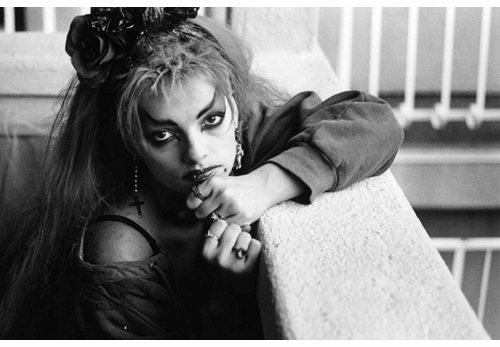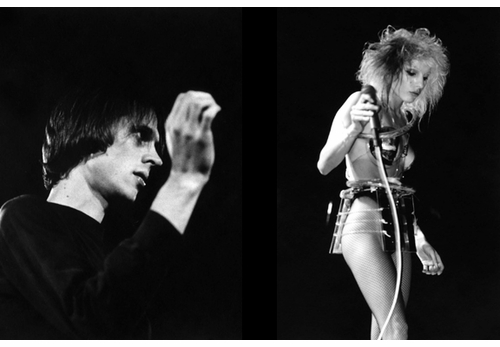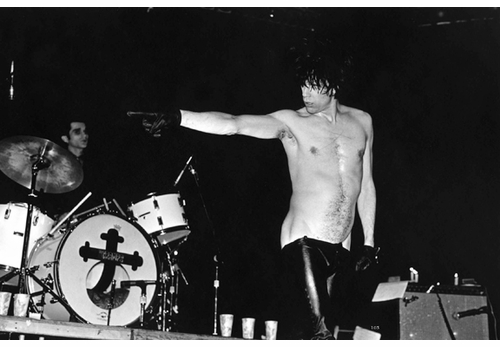| RECENT POSTS DATE 6/1/2025 DATE 5/10/2025 DATE 4/30/2025 DATE 4/26/2025 DATE 4/24/2025 DATE 4/23/2025 DATE 4/21/2025 DATE 4/17/2025 DATE 4/14/2025 DATE 4/10/2025 DATE 4/10/2025 DATE 4/8/2025 DATE 4/7/2025
| | | ANN SUMMA | DATE 10/5/2010In 1977 my husband and I returned from four years in Japan and visited L.A. just to check out the city. We didn't know where we wanted to live, but while we were in town I showed my portfolio to a magazine and they said they'd give me work, so we decided to move here. We wound up in a crummy neighborhood in east Hollywood, and didn't like the city at all during our first few months here.
Nina Hagen at the Tropicana Hotel, West Hollywood, 1979. An eccentric musician prone to onstage rants on subjects ranging from UFOs to animal rights, Hagen formed her first band, Automobil, in 1972.
Then we read an article in the Los Angeles Times about a punk rock club called the Masque and everything changed. By the fall of '78 we were seeing punk bands several nights a week.
The thing that initially interested me about the scene was the people. There were all these kids in great outfits, and the visual style just blew me away. I thought the music was sort of insane at first, but I identified with the people. I'd experienced the rebellion of the '60s, and the punk scene was simultaneously the opposite of that and the same as that. It was full of energy, so raw and so new, and it was completely different from anything else going on. I grew to love the music, too. X was my favorite band, but every band seemed to have a few songs I liked. I felt a little intimidated when I first started going to shows because I didn't look like everyone else. On left: Tom Verlaine, guitarist, lead writer and vocalist for the New York band Television, at the Roxy, October 16, 1981. On right: Dale Bozzio, lead singer for Missing Persons, at the Whiskey a Go Go, 1981.
But, one of the wonderful things about that scene was that even though most people dressed in extreme ways, you felt accepted regardless of how you dressed. There were lots of women in bands, and lots of women photographers, too. Most people aren't aware of how open and tolerant L.A.'s first generation of punk rockers were. During those early years I'd sometimes put my camera away and get into the mosh pit just for fun. You could do that as a woman, and you could do it in ballet flats or tennis shoes, because there was no chance of getting hurt. The scene was playful and actually sort of sweet at the beginning. Then, around 1982, the hardcore boys from the south bay started coming into L.A. for shows and everything changed. An aggressive, male energy took over, and if you got into the mosh pit you felt like you'd get killed. All the women disappeared from the pit — actually, they disappeared from the scene altogether, because it just got uglier and uglier. The last concert I shot was Stiff Little Fingers at the John Anson Ford Theater. It was an incredibly chaotic and violent crowd, and at one point I was almost crushed by a wave of people rushing the stage. I remember thinking I'm not doing this anymore. It's over. Lux Interior, of the Cramps, at the Whiskey a Go Go, May 5, 1980. Interior coined the term “psychobilly” to describe the Cramps' music, a lugubrious and lurid interpretation of delta blues shot through with B movie kitsch, and white trash camp. He died in Los Angeles in 2009.
What had begun as a small, tight community got diluted, and in a period of about four years it dissolved altogether. During those first few years, though, I ran into the same people every night. Somehow you'd find out through the grapevine what was happening and you'd go — and I'm not just talking about punk shows. You'd go to an art performance, or to see King Sunny Ade, and you'd see the same people you'd seen the night before at a tiny punk club. No matter where you went, it felt more like going to a party than to a public event, because you always ran into the same people. It seemed very private at the beginning.
These pictures were out of my consciousness for a really long time because they were taken during the period that I was starting out as a photographer, and I was still learning how to take pictures. But, because I had no formal training as a photographer I was free to make mistakes, and when I look at this work now it feels really loose and alive. I'm also struck by what a unique community that was, how welcoming and truly original it was. I'm happy I was there.
All text and captions excerpted from The Beautiful & the Damned: Punk Photographs by Ann Summa. Captions have been shortened to fit this blog post. Foggy Notion Books/Smart Art Press
Hbk, 9.25 x 12.25 in. / 112 pgs / 182 b&w.
| |
|




